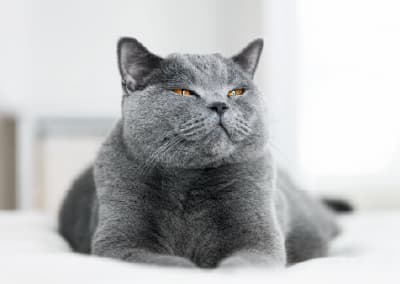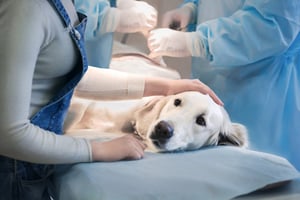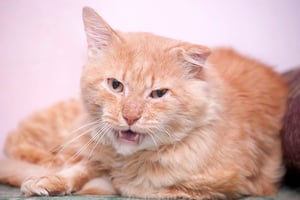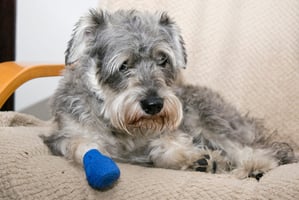We all know that cats hide pain well. But what can we do about it? While validated pain scores are nothing new, there’s data that suggests they’re still not widely used in veterinary practice (Coleman et al 2007, Costa et al 2022, Menendez et al, 2023) and lack of training seems to be a likely cause. In this article, we’ll go over the Feline Grimace Scale – a validated pain scoring tool for cats – and link to resources to help you implement it in clinical practice.
What is the Feline Grimace Scale?
The Feline Grimace Scale (FGS) is a pain-scoring tool developed at the Université de Montréal. By examining videos and photographs of painful cats before and after pain relief, the researchers identified five facial features that consistently differed between patients in pain and those who were comfortable. These were:
- Ear position
- Orbital tightening
- Muzzle tension
- Whisker position
- Head position
Since its development in 2019, the Feline Grimace Scale has been validated for repeatability between professionals, by caregivers, and in different patients – eg kittens, cats undergoing dental extractions, and those having sedation or anaesthesia. In general, the FGS shows good inter-user repeatability for acute pain in cats, which improves further with training. The scale is suitable for kittens and those having dental extractions, but should be used with care within half an hour of sedation or anaesthetic as this may bias scores. The FGS is recommended by WSAVA in their Guidelines for the Recognition, Assessment and Treatment of Pain.
How to use the Feline Grimace Scale
If you suspect a cat is suffering from acute pain, you can use the Feline Grimace Scale to decide whether intervention is necessary.
- Watch the cat (when not grooming, eating, sleeping, or vocalising) for 30 seconds.
- Score each facial feature from 0 to 2, where 0 is absent, 1 is mildly present, and 2 is strongly present
- Ear position – forward and upright (0), pulled apart (1), or rotated down and far apart (2)
- Eye position – Eyes open and round (0), eyes hooded or partially closed (1), eyes shut or squinting (2)
- Muzzle position – relaxed, round muzzle (0), tense muzzle (1), very tense, oval muzzle (2)
- Whisker position – loose and curved (0), straight or only slightly curved (1), straight or moving forward (2)
- Head position – head upright, above shoulder line (0), head level with shoulder line (1), head below shoulder line/hunched shape (2)
- Add up the scores – there’s a maximum score of 10. Anything over 4 suggests analgesia may be necessary, and the higher the score the more severe the pain. Therefore very high scores (9 or 10) may need different analgesic choices to mild scores (4 or 5).
So, as you can see, the Feline Grimace Scale is easy to use and useful for acute pain in most cat patients. Now, let’s look at some tips for incorporating the use of this scale into your day-to-day practice.
4 tips for incorporating the Feline Grimace Scale into your practice
Print copies of the guide
Have copies of the Feline Grimace Scale guide available for staff to use. Put them in easy reach – for example, you could laminate a copy and put in the cat ward to make it easier for staff to correctly assess the cat pain score. Or attach a copy to every clipboard. Or put a copy in the consult room drawers. In other words, make sure there’s a copy to hand wherever you think they’ll be most useful.
Practise, and train the team
The more practice your team gets at pain scoring cats, the better the results will be. More accurate and more consistent results mean you’ll be better able to rely on the results to guide your treatment. Luckily, the Feline Grimace Scale team have created a practice page with pictures of cats you can use to check your skills and see who needs more training.
Train your clients
Because the FGS is only useful for acute pain, it can be tempting to think it’s only useful in the clinic. But training clients in this type of pain scoring is a great way to keep an eye on your patients’ pain, especially in pets prone to recurrent flares of acute pain (eg cats with FLUTD) or for postoperative use. Since the FGS appears to be reliable when used by cat caregivers, scores can even be compared between staff and caregivers day to day.
Consider the app
As vets we’re sometimes a little suspicious of technology, but the creators of the Feline Grimace Scale have also created an app that walks you through the pain score step by step. It’s more useful for cat caregivers, but can also help with the early stages of training for veterinary teams.
Other validated feline pain scores
If the Feline Grimace Scale isn’t for you, there are other cat pain scores available. Alongside the FGC, the WSAVA also recommends the Unesp-Botucatu Feline Pain Scale as it has been well studied and validated. The long version is far more hands-on (including a blood pressure measurement), which can cause stress in our feline patients, but the short version is also validated and doesn’t need so much handling – although palpating the wound or sore area is still one of the assessment points.
The other validated feline pain score is the Glasgow composite measure pain scale-Feline. This is possibly more widely known (thanks to the widespread use of the canine version) but hasn’t been as well studied.
For the technological option, you could also look into Sylvester.Ai, an AI-powered pain recognition tool that has been trained using all three scoring systems. It uses an uploaded photo to assess pain score, giving a certainty too, making it useful for cat caregivers at home. They have a free plan and a paid plan, which includes a dashboard so you can monitor caregiver uploads, client materials, and potential for PIMS integration.
Conclusion
When it comes to recognising feline pain, we could probably all do a little better. The Feline Grimace Scale is a validated tool for assessment of acute pain in cats that’s easy to use for vets, nurses, students, and cat caregivers. Why not get started using it in your clinic today?
_OL_CourseThumb.jpg?width=500&height=300&name=IVE_GPCert(FelP)_OL_CourseThumb.jpg)
Feline Practice
ISVPS General Practitioner Certificate (GPCert)
HAU Postgraduate Certificate (PgC)
After graduating from the University of Nottingham in 2016, Jo moved into small animal practice in the midlands, where she grew a passion for client communication and the subjects that most need it - like geriatrics and dermatology. Since 2020 she has worked as a locum vet in the Channel Islands as well as as a content writer in pet health topics.







